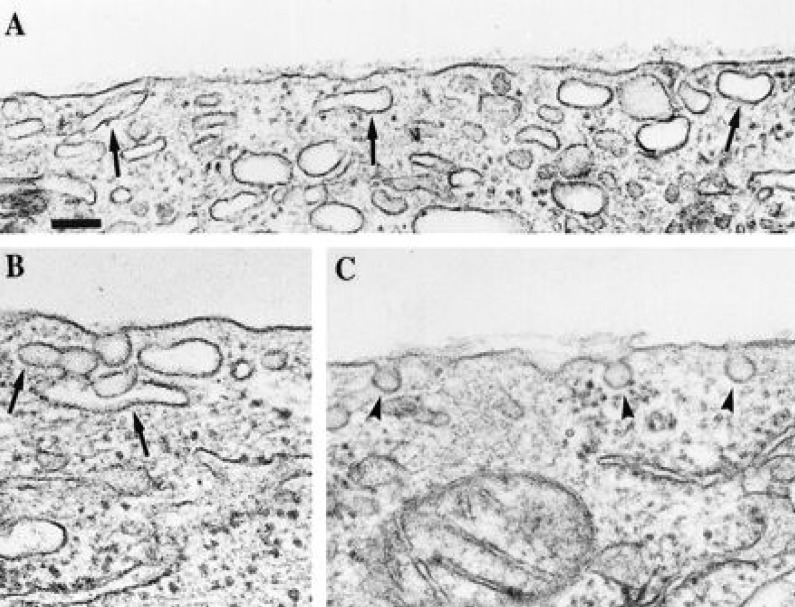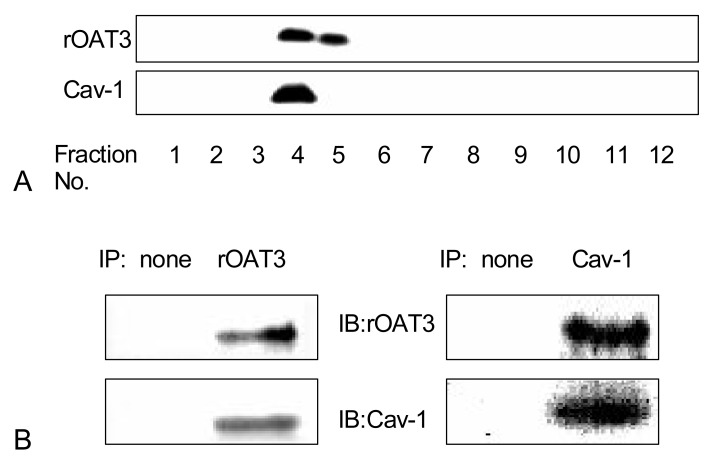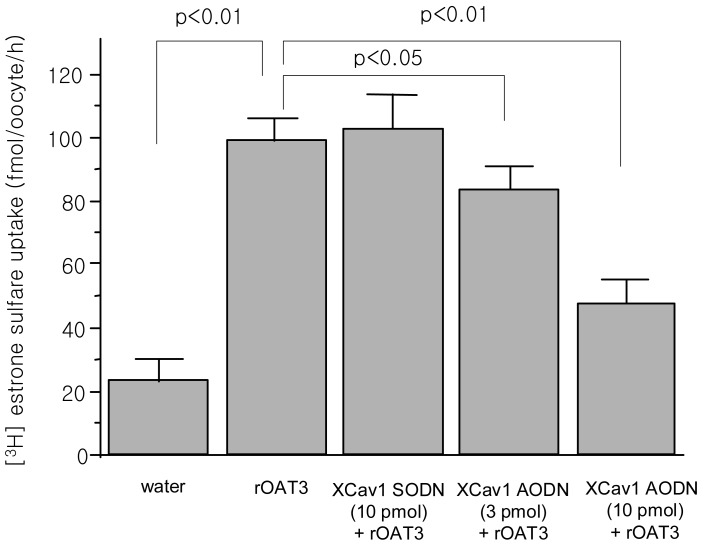Electrolyte Blood Press.
2006 Mar;4(1):8-17. 10.5049/EBP.2006.4.1.8.
Introduction of Organic Anion Transporters (SLC22A) and a Regulatory Mechanism by Caveolins
- Affiliations
-
- 1Department of Laboratory Animal, Medical Research Center, College of Medicine, Yonsei University, Seoul, Korea.
- 2Department of Pharmacology and Toxicology, College of Medicine, Inha University, Inchon, Korea. shcha@inha.ac.kr
- KMID: 2052264
- DOI: http://doi.org/10.5049/EBP.2006.4.1.8
Abstract
- The kidney is an important organ for controlling the volume of body fluids, electrolytic balance and excretion/reabsorption of endogenous and exogenous compounds. Among these renal functions, excretion/reabsorption of endogenous and exogenous substance is very important for the maintenance of physiological homeostasis in the body. Recently discovered organic anion transporters (OAT or SLC22A) have important roles for renal functions. It is well known as drug transporter. Several isoforms belong to SLC22A family. They showed different transport substrate spectrums and different localizations within the kidney. Their gene expressions are changed by some stimulus. The functional transport properties are regulated by protein kinase C. In addition, the function of organic anion transporters are also regulated by protein-protein interaction, such as caveolin which is compositional protein of caveolae structure. In this review, we will give an introduction of organic anion transporters and its regulatory mechanisms.
MeSH Terms
Figure
Reference
-
1. Meier PJ. Molecular mechanisms of hepatic bile salt transport from sinusoidal blood into bile. Am J Physiol. 1995; 269:G801–G812. PMID: 8572210.
Article2. Muller M, Jansen PL. Molecular aspects of hepatobiliary transport. Am J Physiol. 1997; 272:G1285–G1303. PMID: 9227463.
Article3. Moller JV, Sheikh MI. Renal organic anion transport system : pharmacological, physiological, and biochemical aspects. Pharmacol Rev. 1982; 34:315–358. PMID: 6763702.4. Ullrich KJ, Rumrich G. Renal transport mechanisms for xenobiotics : chemicals and drugs. Clin Investig. 1993; 71:843–848.
Article5. Pritchard JB, Miller DS. Mechanisms mediating renal secretion of organic anions and cations. Physiol Rev. 1993; 73:765–796. PMID: 8415925.
Article6. Sperber I. Secretion of organic anions in the formation of urine and bile. Pharmacol Rev. 1959; 11:109–134. PMID: 13633440.7. Weiner I, Mudge GH. Renal tubular mechanisms for excretion of organic acids and bases. Am J Med. 1964; 36:743–762. PMID: 14141450.
Article8. Ullrich KJ, Rumrich G. Contraluminal transport systems in the proximal renal tubule involved in secretion of organic anions. Am J Physiol. 1988; 254:F453–F462. PMID: 3354682.
Article9. Pritchard JB, Miller DS. Comparative insights into the mechanisms of renal organic anion and cation secretion. Am J Physiol. 1991; 261:R1329–R1340. PMID: 1750557.
Article10. Sekine T, Cha SH, Endou H. The multispecific organic anion transporter (OAT) family. Eur J Physiol. 2000; 440:337–350.
Article11. Marshall EKJ, Vicker JL. The mechanisms of the elimination of phenolsulphonphthalein by the kidney -a proof of secretion by the convoluted tubules. Bull Johns Hopkins Hosp. 1923; 34:1–7.12. Youngblood GL, Sweet DH. Identification and functional assessment of the novel murine organic anion transporter Oat5 (Slc22a19) expressed in kidney. Am J Physiol. 2004; 287:F236–F244.
Article13. Monte JC, Nagle MA, Eraly SA, Nigam SK. Identification of a novel murine organic anion transporter family member, OAT6, expressed in olfactory mucosa. Biochem Biophys Res Commun. 2004; 323:429–436. PMID: 15369770.
Article14. Sweet DH, Wolff NA, Pritchard JB. Expression cloning and characterization of ROAT1. The basolateral organic anion transporter in rat kidney. J Biol Chem. 1997; 272:30088–30095. PMID: 9374486.15. Uwai Y, Okuda M, Takami K, Hashimoto Y, Inui KI. Functional characterization of the rat multispecific organic anion transporter OAT1 mediating basolateral uptake of anionic drugs in the kidney. FEBS Lett. 1998; 438:321–324. PMID: 9827570.
Article16. Lu R, Chan BS, Schuster VL. Cloning of the human kidney PAH transporter : narrow substrate specificity and regulation by protein kinase C. Am J Physiol. 1999; 276:F295–F303. PMID: 9950961.17. Takeda M, Sekine T, Endou H. Regulation by protein kinase C of organic anion transport dirived by rat organic anion transporter 3 (rOAT3). Life Sci. 2000; 67:1087–1093. PMID: 10954042.18. Zhou f, Illsley np, You G. Functional characterization of a human organic anion transporter hOAT4 in placental BeWo cells. Eur J Pharm Sci. 2006; (in press).
Article19. Kuze K, Graves P, Leahy A, Wilson P, Stuhlmann H, You G. Heterologous expression and functional characterization of a mouse renal orgnic anion transporter in mammalian cells. J Biol Chem. 1999; 274:1519–1524. PMID: 9880528.20. Shimada H, Moewes B, Burckhardt G. Indirect coupling to Na of p-aminohippuric acid uptake into rat renal basolateral membrane vesicles. Am J Physiol. 198; 253:F795–F801. PMID: 3120599.
Article21. Pritchard JB. Intracellular α-ketoglutarate controls the efficacy of renal organic anion trasnport. J Pharmacol Exp Ther. 1995; 274:1278–1284. PMID: 7562499.22. Prichard JB. Coupled transport of p-aminohippurate by rat basolateral membrane vesicles. Am J Physiol. 1988; 255:F597–F604. PMID: 3177651.23. Masereeuw R, Russel FGM, Miller DS. Multiple pathways of organic anion secretion in renal proximal tubule revealed by confocal microscopy. Am J Physiol. 1996; 271:F1173–F1182. PMID: 8997391.
Article24. Burckhardt G, Porth J, Wolff NA. Functional and molecular characterization of renal transporters for p-aminohippurate (PAH). Nova Acta Leopoldina. 1998; 78:35–40.25. Hosoyamada M, Sekine T, kanai Y, Endou H. Molecular cloning and functional expression of a multispecific organic anion transporter from human kidney. Am J Physiol. 1999; 276:F122–F128. PMID: 9887087.26. Race JE, Grassl SM, Willians WJ, Holtzaman EJ. Molecular cloning and characterization of two nevel human renal organic anion transporters (hOAT1 and hOAT3). Biochem Biophys Res Commun. 1999; 255:508–514. PMID: 10049739.27. Wolff NA, Werner A, Burkhardt S, Burckhardt G. Expression cloning and characterization of a renal organic anion transporter from winter flounder. FEBS Lett. 1997; 417:287–291. PMID: 9409735.
Article28. Apiwattanakul N, Sekine T, Chaioungdua A, Kanai Y, Nakajima N, Sophasan S, Endou H. Transport properties of nonsteroidal anti-inflammatory drugs by organic anion transporter 1 expressed in Xenopus laevis oocytes. Mol Pharmacol. 1999; 55:847–854. PMID: 10220563.29. Jariyawat S, Sekine T, Takeda M, Apiwattanakul N, Kanai Y, Sophasan S, Endou H. The interaction and transport of β-lactam antibiotics with the cloned rat renal organic anion transporter 1 (OAT1). J Pharmacol Exp Ther. 1999; 290:672–677. PMID: 10411577.30. Wada S, Tsuda M, Sekine T, Cha SH, Kimura M, Kanai Y, Endou H. Rat multispecific organic anion transporter 1 (rOAT1) transports zidovudine, acyclovir, and other antiviral nucloside analogs. J Pharmacol Exp Ther. 2000; 294:844–849. PMID: 10945832.31. Sekine T, Cha SH, Kanai Y, Endou H. Molecular biology of multispecific organic anion transporter family (OAT family). Clin Exp Nephrol. 1999; 3:237–243.
Article32. Ullrich KJ. Renal transporters for organic anions and organic cations, structure requirements for substrantes. J Membrane Biol. 1997; 158:95–107. PMID: 9230087.33. Tsuda M, Sekine T, Takeda M, Cha SH, Kanai Y, Kimura M, Endou H. Transport of ochratoxin A by renal multispecific organic anion transporter 1. J Pharmacol Exp Ther. 1999; 289:1301–1305. PMID: 10336520.34. Endou H. Recent advances in molecular mechanisms of nephrotoxicity. Toxicol Lett. 1998; 102-103:29–33. PMID: 10022228.
Article35. Burckhardt BC, Wolff NA, Burckhardt G. Electrophysiological characterization of an orgnic anion transporter cloned from winter flounder kidney (fROAT). J Am Soc Nephrol. 2000; 11:9–17. PMID: 10616835.36. Tojo A, Sekine T, Nakajima N, Hosoyamada M, Kanai Y, Kimura K, Endou H. Immunohistochemical localization of multispecific renal organic anion transporter 1 in rat kidney. J Am Soc Nephrol. 1999; 10:464–471. PMID: 10073596.
Article37. Nakajima N, Sekine T, Cha SH, Tojo A, Hosoyamada M, Kanai Y, Yan K, Awa S, Endou H. Develpmental changes in multispecific organic anion transporter 1 (OAT1) expression in the rat kidney. Kidney Int. 2000; 57:1608–1616. PMID: 10760096.38. Kim GH, Na KY, Kim SY, Joo KW, Oh Y, Chae SW, Endou H, Han JS. Up-regulation of organic anion transporter 1 protein is induced by chronic furosemie or hydrochlorothiazide infusion in rat kidney. Nephrol Dial Transplant. 2003; 18:1505–1511. PMID: 12897087.39. Simonson GD, Vincent AC, Roberg KJ, Huang Y, Iwanij V. Molecular cloning and characterization of a novel liver-specific transport protein. J Cell Sci. 1994; 107:1065–1072. PMID: 8056831.
Article40. Sekine T, Cha SH, Tsuda M, Apiwattanakul N, Nakajima N, Kanai Y, Endou H. Identification of multispecific organic anion transporter e expressed predominantly in the liver. FEBS Lett. 1998; 429:179–182. PMID: 9650585.41. Kojima R, Sekine T, Kawachi M, Cha SH, Suzuki Y, Endou H. Immunolocalization of multispecific organic anion transporters, OAT1, OAT2, and OAT3, in rat kidney. J Am Soc Nephrol. 2002; 13:848–857. PMID: 11912243.
Article42. Kobayashi Y, Ohshiro N, shibusawa A, Sasaki T, Tokuyama S, Sekine T, Endou H, Yamamoto T. Isolation, characterization and differential gene expression of multispecific organic anion transporter 2 in Mice. Mol Pharm. 2002; 62:7–14.
Article43. Cha SH, Kim HP, Jung NH, Lee WK, Kim JY, Cha YN. Down-regulation of organic anion transporter 2 mRNA expression by nitric oxide in primary cultured rat hepatocytes. IUBMB Life. 2002; 54:129–135. PMID: 12489640.
Article44. Kusuhara H, Sekine T, Utsunomiya-Tate N, Tsuda M, Kojima R, Cha SH, Sugiyama Y, kanai Y, Endou H. Molecular cloning and characterization of a new multispecific organic anion transporter from rat brain. J Biol Chem. 1999; 274:13675–13680. PMID: 10224140.
Article45. Sweet DH, Chan LM, Walden R, Yang XP, Miller DS, Pritchard JB. Organic anion transporter 3 (Slc22a8) is a dicarboxylate exchanger indirectly coupled to the Na+ gradient. Am J Physiol. 2003; 284:F763–F769.46. Cha SH, Sekine T, Fukushima J, Kanai Y, Kobayashi Y, Goya T, Endou H. Identification and characterization of human organic anion transporter 3 expressing predominantly in the kidney. Mol Pharmacol. 2001; 59:1277–1286. PMID: 11306713.
Article47. Cha SH, Sekine T, Kusuhara H, Yu E, Kim JY, Kim DK, Sugiyama Y, Kanai Y, Endou H. Molecular cloning and characterization of multispecific organic anion transporter 4 expressed in the placenta. J Biol Chem. 2000; 275:4507–4512. PMID: 10660625.
Article48. Ekaratanawong S, Anzai N, Jutabha P, Miyazaki H, Noshiro R, Takeda M, Kanai Y, Sophasan S, Endou H. Human organic anion transporter 4 is a renal apical organic anion/dicarboxylate exchanger in the proximal tubule. J Pharmacol Sci. 2004; 94:297–304. PMID: 15037815.49. Sun W, Wu RR, van Poelje PD, Erion MD. Isolation of a family of organic anion transporters from human liver and kidney. Biochem Biophys Res Commun. 2001; 283:417–422. PMID: 11327718.
Article50. Kwak JO, Kim HW, Oh KJ, Ko CB, Park H, Cha SH. Characterization of mouse organic anion transporter 5 as a renal steroid sulfate transporter. J Steroid Biochem Mol Biol. 2005; 97:369–375. PMID: 16150593.
Article51. Anzai N, Jutabha P, Enomoto A, Yokoyama H, Nonoguchi H, Hirata T, Shiraya K, He X, Cha SH, Takeda M, Miyazaki H, Sakata T, Tomita K, Igarashi T, Kanai Y, Endou H. Functional characterization of rat organic anion transporter 5 (Slc22a19) at the apical membrane of renal proximal tubules. J Pharmacol Exp Ther. 2005; 315:534–544. PMID: 16079298.
Article52. Schnabolk GW, Youngblood GL, Sweet DH. Transport of Estrone Sulfate by the Novel Organic Anion Transporter Oat6 (Slc22a20). Am J Physiol. 2006; (in press).
Article53. Cai C, Zhu H, Chen J. Overexpression of caveolin-1 increases plasma membrane fluidity and reduces P-glycoprotein function in Hs578T/Dox. Biochem Biophys Res Commun. 2004; 320:868–874. PMID: 15240128.
Article54. McDonald KK, Zharikov S, Block ER, Kilberg MS. A caveolar complex between the cationic amino acid transporter 1 and endothelial nitric-oxide synthase may explain the "arginine paradox". J Biol Chem. 1997; 272:31213–31216. PMID: 9395443.
Article55. Karlsson M, Thorn H, Parpal S, Stralfors P, Gustavsson J. Insulin induces translocation of glucose transporter GLUT4 to plasma membrane caveolae in adipocytes. FASEB J. 2002; 16:249–251. PMID: 11744627.
Article56. Bossuyt J, Taylor BE, James-Kracke M, Hale CC. Evidence for cardiac sodium-calcium exchanger association with caveolin-3. FEBS Lett. 2002; 511:113–117. PMID: 11821059.
Article
- Full Text Links
- Actions
-
Cited
- CITED
-
- Close
- Share
- Similar articles
-
- Molecular Physiology of Renal Organic Anion Transporters
- Molecular aspects of organic ion transporters in the kidney
- Effects of Increased Uric Acid Intake on the Abundance of Urate-anion exchanger and Organic Anion Transporter Proteins in the Rat Kidney
- Effects of Losartan Administration on Uric acid Transporters in Rat Kidney
- Association of rOAT1 with Caveolin-1 in Rat Kidney






